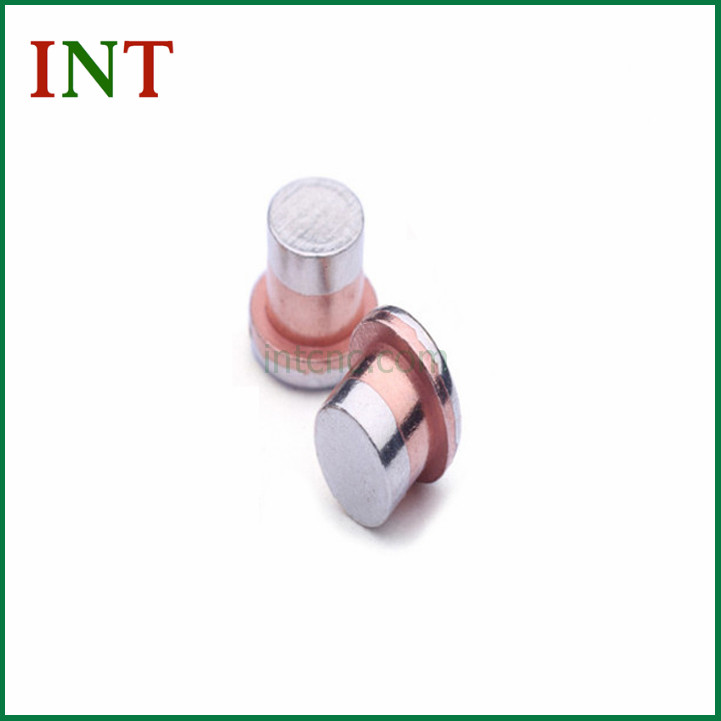Composition and Properties of CdO Contact Rivets
2024-06-13
AgCdO (Silver Cadmium Oxide) contact rivets are widely used in electrical engineering and electronics, particularly in applications involving electrical contacts such as relays, switches, and circuit breakers. Here’s a detailed overview:
Composition and Properties
1. Silver (Ag): Silver is known for its excellent electrical and thermal conductivity, low contact resistance, and high melting point, making it ideal for electrical contacts.
2. Cadmium Oxide (CdO): Cadmium oxide is added to silver to enhance its arc-quenching properties and resistance to welding and erosion. It helps maintain the integrity of the contact surface during electrical arcing.
Key Features and Benefits
1. High Electrical Conductivity: The silver component ensures low electrical resistance, allowing efficient current flow.
2. Thermal Stability: AgCdO contacts can withstand high temperatures, making them suitable for high-current applications.
3. Arc Resistance: Cadmium oxide enhances the material's ability to resist arcing, reducing contact wear and extending the lifespan of the contact.
4. Anti-Welding Properties: The presence of cadmium oxide prevents the contacts from welding together under high current loads, ensuring reliable operation.
5. Durability: AgCdO contacts exhibit good mechanical strength and durability, capable of withstanding frequent switching operations.
Applications
1. Relays: Used in various types of relays, including electromagnetic and solid-state relays, where reliable contact performance is critical.
2. Switches: Found in industrial and household switches, providing consistent and safe switching operations.
3. Circuit Breakers: Essential in protecting electrical circuits by breaking the circuit under fault conditions without welding the contacts.
4. Contactors: Utilized in contactors for controlling high-power circuits, ensuring long service life and reliable performance.
5. Electrical Panels: Incorporated in electrical panel components to ensure safe and efficient distribution of electrical power.
Manufacturing and Shapes
AgCdO contact rivets can be manufactured in various shapes and sizes to suit different applications:
1. Solid Rivets: Made entirely of AgCdO material, used in applications where maximum arc resistance and durability are required.
2. Bimetal Rivets: Combine AgCdO with a base metal (such as copper) to reduce cost while maintaining good electrical conductivity and arc resistance.
3. Tri-metal Rivets: Feature a layer of AgCdO sandwiched between two layers of base metal, offering a balance between performance and cost.
Environmental and Health Considerations
1. Cadmium Content: Cadmium is a toxic heavy metal, and its use is regulated due to environmental and health concerns. Proper handling, recycling, and disposal practices are essential to minimize the impact.
2. Regulations: Many regions have strict regulations regarding the use of cadmium, such as the RoHS (Restriction of Hazardous Substances) directive in the European Union. Alternative materials like AgSnO2 (Silver Tin Oxide) are sometimes used to comply with these regulations.
Alternatives to AgCdO
Due to environmental concerns, alternative materials are sometimes used:
1. AgSnO2 (Silver Tin Oxide): Offers similar properties to AgCdO with less environmental impact.
2. AgNi (Silver Nickel): Provides good conductivity and arc resistance, though not as high as AgCdO.
3. AgWC (Silver Tungsten Carbide): Used in high-current applications requiring superior arc resistance.
Summary
AgCdO contact rivets are essential components in various electrical devices, providing reliable performance in high-current and high-voltage applications. While they offer excellent properties such as high conductivity, arc resistance, and durability, the use of cadmium necessitates careful consideration of environmental and health impacts. With evolving regulations, alternatives like AgSnO2 are increasingly being adopted in certain applications.



